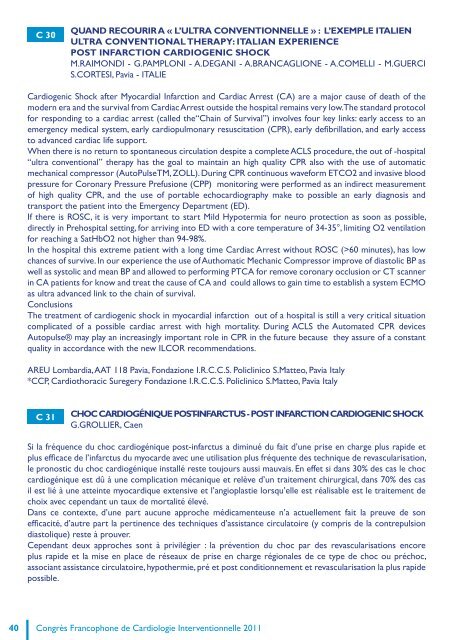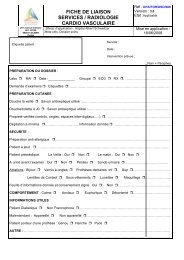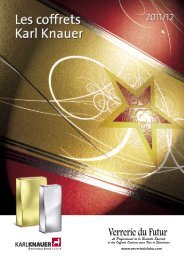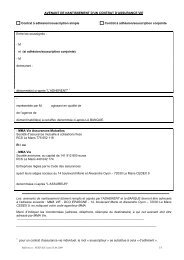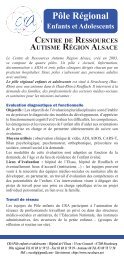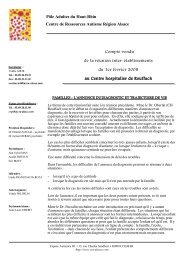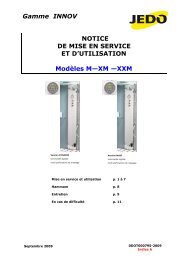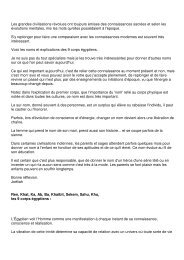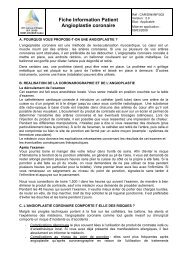Francophone - Webagoo.eu
Francophone - Webagoo.eu
Francophone - Webagoo.eu
Create successful ePaper yourself
Turn your PDF publications into a flip-book with our unique Google optimized e-Paper software.
C 30<br />
QUAND RECOURIR A « L’ULTRA CONVENTIONNELLE » : L’EXEMPLE ITALIEN<br />
ULTRA CONVENTIONAL THERAPY: ITALIAN EXPERIENCE<br />
POST INFARCTION CARDIOGENIC SHOCK<br />
M.RAIMONDI - G.PAMPLONI - A.DEGANI - A.BRANCAGLIONE - A.COMELLI - M.GUERCI<br />
S.CORTESI, Pavia - ITALIE<br />
Cardiogenic Shock after Myocardial Infarction and Cardiac Arrest (CA) are a major cause of death of the<br />
modern era and the survival from Cardiac Arrest outside the hospital remains very low. The standard protocol<br />
for responding to a cardiac arrest (called the“Chain of Survival”) involves four key links: early access to an<br />
emergency medical system, early cardiopulmonary resuscitation (CPR), early defibrillation, and early access<br />
to advanced cardiac life support.<br />
When there is no return to spontaneous circulation despite a complete ACLS procedure, the out of -hospital<br />
“ultra conventional” therapy has the goal to maintain an high quality CPR also with the use of automatic<br />
mechanical compressor (AutoPulseTM, ZOLL). During CPR continuous waveform ETCO2 and invasive blood<br />
pressure for Coronary Pressure Prefusione (CPP) monitoring were performed as an indirect measurement<br />
of high quality CPR, and the use of portable echocardiography make to possible an early diagnosis and<br />
transport the patient into the Emergency Department (ED).<br />
If there is ROSC, it is very important to start Mild Hypotermia for n<strong>eu</strong>ro protection as soon as possible,<br />
directly in Prehospital setting, for arriving into ED with a core temperature of 34-35°, limiting O2 ventilation<br />
for reaching a SatHbO2 not higher than 94-98%.<br />
In the hospital this extreme patient with a long time Cardiac Arrest without ROSC (>60 minutes), has low<br />
chances of survive. In our experience the use of Authomatic Mechanic Compressor improve of diastolic BP as<br />
well as systolic and mean BP and allowed to performing PTCA for remove coronary occlusion or CT scanner<br />
in CA patients for know and treat the cause of CA and could allows to gain time to establish a system ECMO<br />
as ultra advanced link to the chain of survival.<br />
Conclusions<br />
The treatment of cardiogenic shock in myocardial infarction out of a hospital is still a very critical situation<br />
complicated of a possible cardiac arrest with high mortality. During ACLS the Automated CPR devices<br />
Autopulse® may play an increasingly important role in CPR in the future because they assure of a constant<br />
quality in accordance with the new ILCOR recommendations.<br />
AREU Lombardia, AAT 118 Pavia, Fondazione I.R.C.C.S. Policlinico S.Matteo, Pavia Italy<br />
*CCP, Cardiothoracic Suregery Fondazione I.R.C.C.S. Policlinico S.Matteo, Pavia Italy<br />
C 31<br />
CHOC CARDIOGÉNIQUE POST-INFARCTUS - POST INFARCTION CARDIOGENIC SHOCK<br />
G.GROLLIER, Caen<br />
Si la fréquence du choc cardiogénique post-infarctus a diminué du fait d’une prise en charge plus rapide et<br />
plus efficace de l’infarctus du myocarde avec une utilisation plus fréquente des technique de revascularisation,<br />
le pronostic du choc cardiogénique installé reste toujours aussi mauvais. En effet si dans 30% des cas le choc<br />
cardiogénique est dû à une complication mécanique et relève d’un traitement chirurgical, dans 70% des cas<br />
il est lié à une atteinte myocardique extensive et l’angioplastie lorsqu’elle est réalisable est le traitement de<br />
choix avec cependant un taux de mortalité élevé.<br />
Dans ce contexte, d’une part aucune approche médicament<strong>eu</strong>se n’a actuellement fait la pr<strong>eu</strong>ve de son<br />
efficacité, d’autre part la pertinence des techniques d’assistance circulatoire (y compris de la contrepulsion<br />
diastolique) reste à prouver.<br />
Cependant d<strong>eu</strong>x approches sont à privilégier : la prévention du choc par des revascularisations encore<br />
plus rapide et la mise en place de réseaux de prise en charge régionales de ce type de choc ou préchoc,<br />
associant assistance circulatoire, hypothermie, pré et post conditionnement et revascularisation la plus rapide<br />
possible.<br />
40 Congrès <strong>Francophone</strong> de Cardiologie Interventionnelle 2011


